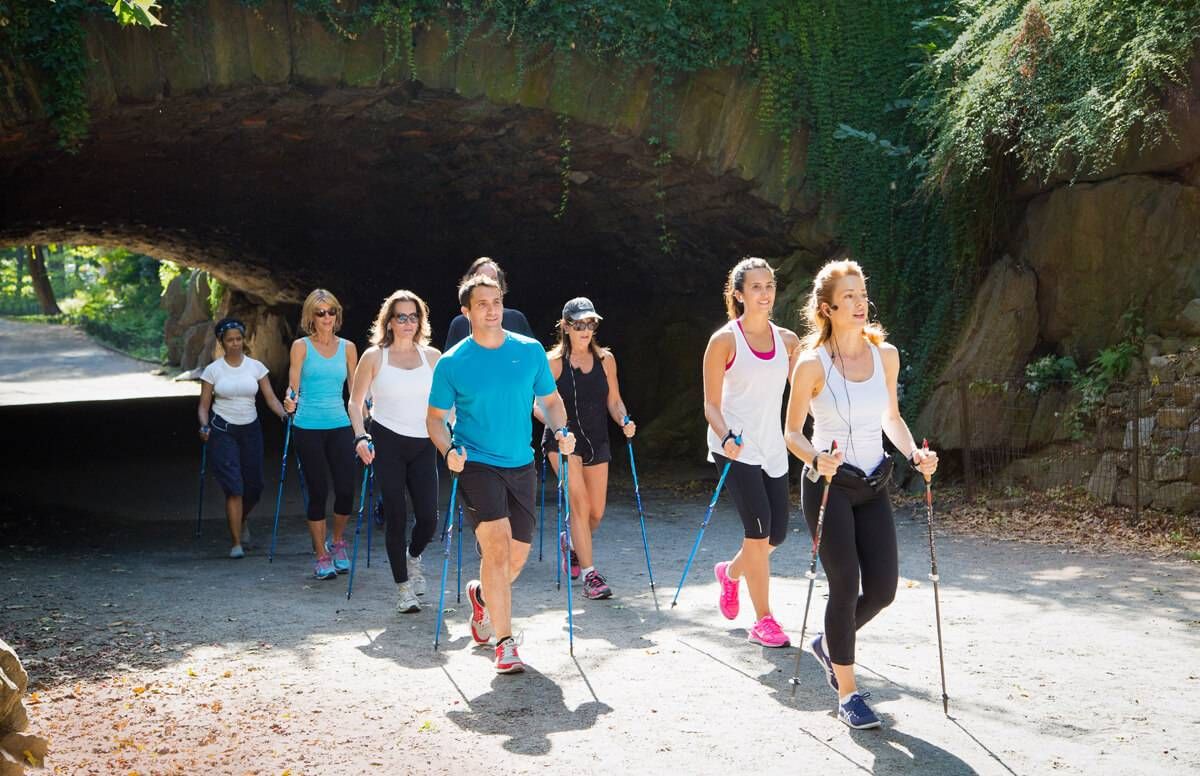How Nordic Walking Can Improve Your Overall Fitness
With the right technique, walking with Nordic poles is a full-body workout
If you're looking to make new friends or even just have a chat with a stranger, while improving your overall fitness, let me suggest taking up Nordic walking.

Almost every time I grab my sticks and head out for a vigorous stroll, regardless of the season, someone approaches me with questions about why I'm loping along gripping a specially-designed pole in each hand. While in Florida visiting my retired parents, I found my mother's Nordic poles. After watching a few YouTube videos with instructions on form and technique, I grabbed them for my daily 45-minute walk on the beach.
At the end of my first trial run — er, walk — I experienced a heightened exhilaration and less weariness than after my usual brisk turn. I liked the feeling so much that I pledged to go Nordic walking every day for a month to test the value of the activity.
Using Nordic Poles Does Make a Difference
Unlike regular walking, adding the rhythmic motion of swinging and pushing off with Nordic poles works the body more strenuously. Research has found that Nordic pole walking uses 90 percent of a walker's muscles, conditioning the upper and lower body and burning almost as many calories as jogging. But, unlike jogging, Nordic walking is low impact on the joints, which makes it especially appealing to people over 50.
Nordic walking began in Finland when cross-country skiers began using poles to train after the snow melted. The activity spread across Europe, where today some 15 million people regularly pick up their walking poles and go. The poles can fold up and have flat rubber bottoms, making it easy to travel with them.
According to multiple scholarly studies compiled by the International Nordic Walking Association, Nordic walking achieves demonstrably positive health effects for people with conditions ranging from diabetes to heart disease to arthritis.
"Nordic walking has so many advantages. It is a full-body workout that can be done anywhere, on any walkable surface and in any climate," says Bernd Zimmermann, 76, president of the American Nordic Walking Association, which he founded in 2004.
For Nordic Walking, Not Just Any Poles Will Do
You might wonder if you can just use ski poles or hiking poles you might already have. But Zimmermann says it's important to use specific Nordic walking poles. That's because they're adjustable, lightweight and have shock-absorbing tips. They retail from about $50 to $200 a pair.
"Nordic walking poles have a special strap; the hand slides in like a glove, making the pole an extension of your arm. That way you can't lose it and it gives you more leverage when you walk," Zimmermann says. "You absolutely cannot use ski poles, or the heavier hiking or trekking poles, which are meant for mountainous terrain."
Zimmermann also stresses that taking a Nordic walking class helps participants achieve maximum benefits from their workout. His organization certifies Nordic walking instructors, many of them personal trainers, chiropractors and physical therapists. The training prepares them to work with novice walkers at clinics and through Meetup groups, clubs and classes at community and senior centers.
"People think, 'I know how to walk,' but there is a learning curve," Zimmermann says. "If people invest the time to learn this technique, the diagonal stride, they will get the best results. And when they get results, they are hooked."
Nordic Walking for Injury Recovery and Travel
Sammy Smith, 62, took up Nordic walking after breaking two metatarsals, the long bones in her foot, two years ago.
Following surgery, the Atlanta archaeologist couldn't put weight on her foot for eight weeks. Her physical therapist recommended using Nordic walking poles as she resumed her normal activity.
"The poles allowed me to be upright with a correct body position while the muscles in my foot were learning to work again," says Smith. "When I used them, I didn't bob around. I felt far less strain on my foot, hip, knee and lower extremities."
Smith was still recovering when she and her husband left for a long-planned trip to France. She packed her "batons" in her suitcase and used them as they toured Marseille, Avignon, Aix-en-Provence and Paris.
"Walking on uneven surfaces, you need those stabilizers," she says. "Four points of contact is better than two when we were on cobblestones, getting on and off trains and going up stairs. In France, no one blinks when you use them; I walked into the Louvre with my sticks."
Smith credits the poles with speeding the pace of her recovery.
"When I learned to concentrate on propelling myself with my butt muscles, my posture shifted instantly into a better form. I had more mindfulness, more awareness of my gait," she says.
Nordic Walking and the Brain
That engagement of the brain is a bonus for Nordic walkers, according to Sonja Johansson.
A movement therapist in New York City, Johansson works in a clinical setting and uses the poles for therapeutic walking with clients who have Parkinson's disease or are recovering from strokes.
"They can become wobbly when they walk and the poles give them balance and stability," she says. "When there are two extra things to trip over, you have to pay attention and be conscious of what your arms and legs are doing. When you expose yourself to novel experiences, it can lead to positive architectural changes in the brain."
For Fitness and Fun
Johansson also teaches Nordic walking for fun. As co-founder of HYVÄ Nordic Walking, she trains clients who want to use the poles for a full-body workout or when rehabbing a hip, knee or ankle injury.
"I work with older clients who were runners or hikers or were previously more fit and have become sedentary," she says. "They want to resume being physically active and being outdoors. They don't have to work at one hundred percent intensity to do something good for themselves."
In addition, Johansson leads group Nordic walking classes on sidewalks and gravel paths that intersect Central Park in New York City, providing each participant with poles and headsets so they can walk to the beat of recorded music and hear her coaching reminders on form and technique.
"It's not as simple as it appears," she says. "The elbows have to be straight, with the pole on a forward slant. When you're walking, you push off like a gondolier does. When you use the poles correctly, you dynamically engage your core as well as your arms and legs. That's what makes it Nordic walking and not just carrying poles."
One of Johannson's comments really struck a nerve with me and my experience. I found myself nodding in agreement when she told me that Nordic walking improves the way you walk when you don't have your poles.
My Experience Trying Nordic Walking
I typically walk outdoors to boost my mood and clear my head, as well as to elevate my heart rate. But after I've walked for a half hour or so, I believe that my form deteriorates, leading me to slump as I tire a bit. Walking with the poles seems to help, though. Their support keeps my carriage upright. I've noticed that my posture is better even after my walk concludes.
As I wrapped up my 30 days of Nordic walking, I can point to a few incremental positives from my unscientific trial.
For one, although I live with a temperamental lower back, an arthritic hip and one flat foot, after a month walking with poles, my minor aches and pains seemed diminished. I'm certain that I felt less stiffness, especially when I woke up and got moving.
And I could be wrong, but it looked like my upper arms were a bit more toned!
Bolstered by my results and enlightened by what I learned reporting this story, I plan to continue to regularly use the poles for my daily exercise.
And I'm looking forward to sharing my conclusions with the curious strangers whom I'll inevitably meet while I'm Nordic walking.


